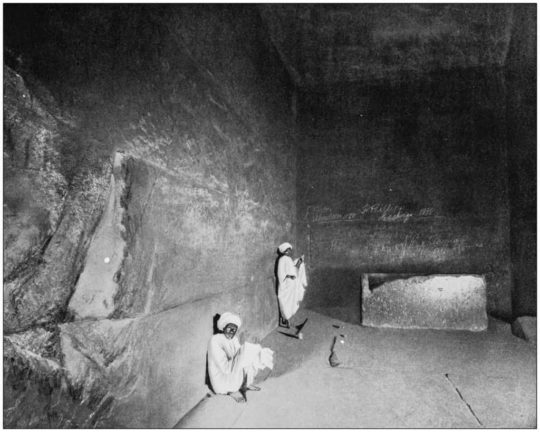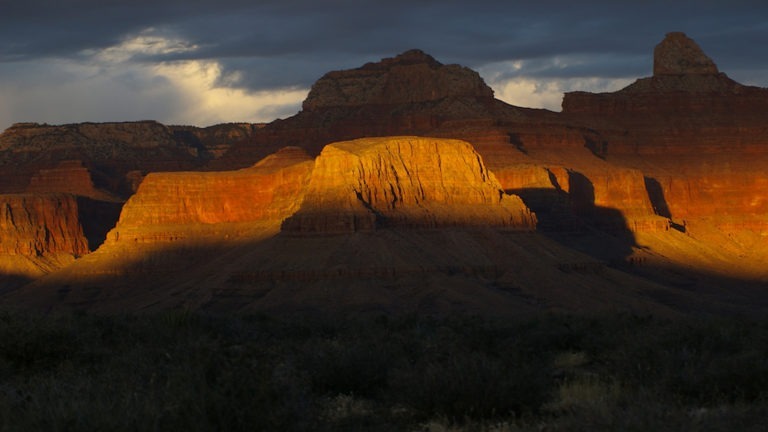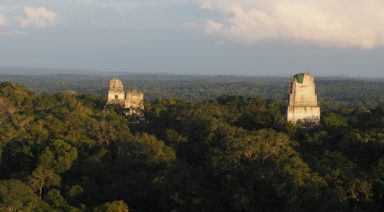The Book of Enoch Might Tell a Different Story of the Pyramids

Biblical stories are often fantastical, unbelievable, and sometimes confusing when it comes to interpreting their meaning. Of the apocryphal biblical texts, there are few more enigmatic and fascinating than the Book of Enoch, and in certain sects of Christianity, these books are still part of the dominant biblical canon. But could clues from these texts provide evidence of a completely different story of our ancient ancestors, namely one involving visits from an advanced extraterrestrial race?
Giants in the Book of Enoch
When the Book of Enoch was found in the Dead Sea Scrolls, it became clear it was a piece of literature that influenced biblical writers of the time including those who wrote the New Testament. So why is the Book of Enoch not in the Bible?
Today the Book of Enoch is only included in the main canons of Ethiopian Orthodox sects but was popular for hundreds of years in ancient Jewish perspectives. In fact, in understanding the Book of Enoch, some have pointed out that it was likely the inspiration for the Book of Genesis, due to a number of parallels.
Within the book, we find the story of Enoch who was the father of Methuselah and grandfather of Noah. He lived for 365 years up until the great flood that wiped out much of the population. Enoch was taken away in a fiery chariot before the great floods by the Archangel Michael, who some have interpreted as being extraterrestrial. Could that fiery chariot actually have been a spacecraft powered by a jet-engine?
The book that details the story of Enoch is extensive with over 100 chapters dispersed throughout several books, detailing accounts of the Nephilim and the Watchers. These giants, known as the Nephilim, are also described in the Book of Genesis. The giants are said to have been the progeny of angels, known as The Watchers, and female humans.

The ancient astronaut view of these biblical stories sees these Watchers as an advanced extraterrestrial race, who were perceived as angels, some good and some bad. Their presence among our human ancestors is thought to be either the reason we exist on this planet — the extraterrestrials being our progenitors — or the reason we advanced rapidly as beings capable of starting complex civilizations.
Some point to a particular passage that describes an account from Enoch’s grandson, Lamech, during the birth of his son, which read:
“And his father, Lamech, was afraid of him and fled, and come to his father Methuselah. And he said to him: ‘I have begotten a strange son, different and unlike man, and resembling the sons of the God of heaven; and his nature is different and he is not like us, and his eyes are as the rays of the sun, and his face is glorious.”
This was a description of Noah who would later go on to build the ark and survive the flood, sent to wipe out the Nephilim and cleanse humanity of its impurities.
But what was Enoch’s relationship with the Nephilim and the gods who created them? Enoch’s grandson was chosen to build the Ark to survive the flood, while Enoch himself was taken away by the “angels.” Could Enoch have left behind any clues for humanity that could have survived the flood? Some point to the ancient pyramids in Egypt as the answer.
The Book of Enoch and The Ancient Sumerians
There is some crossover in the biblical texts of Enoch and ancient Sumerian texts, particularly when it comes to the Watchers. Known as the Annunaki, or visitors from a planet called Nibiru, the Sumerians also looked upon these Watchers as gods, showing a crossover between the two ancient cultures. In the Book of Enoch, there is also mention of the great Sumerian ruler Gilgamesh, who often describes the Annunaki in much the same way Enoch describes the Watchers.
Throughout the bible and the Epic of Gilgamesh, the gods often did not like to show their faces and communicated through transmitters where the voice of the gods could be heard, but not seen. Today, we have technology like this, allowing us to speak to people without seeing their face, could they have been referencing something like a telephone or telecom?
Ancient astronaut theories have interpreted this secrecy as extraterrestrials not being able to take off their helmets and having bases on mountains, which were kept hidden from humans. This is a recurring theme in biblical texts and particularly the Epic of Gilgamesh. In fact, in the seventh tablet of the Epic of Gilgamesh, he describes being brought to a door that speaks like a living person — much like the intercoms we’re familiar with today.
The ancient Sumerians also built pyramids of their own, called ziggurats. These ziggurats were places of protection during floods and were also topped with thrones for their gods. Erich von Däniken says he believes that the Egyptian pyramids could have also been built for a similar purpose, protecting something from the great flood of biblical texts.
Like the Epic of Gilgamesh, some believe there to be a lost 10th Sumerian tablet that details how the Annunaki built the pyramids in Egypt, which could draw a definitive connection between these two advanced ancient civilizations and an advanced visitor race.
A False Narrative of the Pyramids
As it turns out, the Great Pyramid at Giza, otherwise known as the Pyramid of Cheops or Khufu, may not have been attributed to the person who ordered its construction. It seems there is actually significant evidence the pyramid was not built by Khufu, and the only reason historians and archeologists date it to the 4th dynasty is due to a questionable discovery by English Egyptologist, Major-General Richard Vyse.
Author and alternative theorist, Zecharia Sitchin, found that there is ample evidence that Vyse, after spending over a million dollars on an expedition into the upper chambers of the Great Pyramid, came up empty-handed and forged the cartouche of Cheops.

Inside the pyramid of Khufu
Upon discovering Vyse’s private journal, it noted that he could not find a cartouche or any hieroglyphics in the King’s chamber, despite desperately searching for them. However, in his book written of the expedition three years later, it says that he did find just one.
Many believe it possible that he drew the cartouche himself, in order to label his expedition a success and appease his investors. Interestingly, the chamber had also been previously visited by explorers with no one having seen the cartouche until Vyse allegedly discovered it.
Sitchin also pointed out that the name of Khufu had been misspelled in the cartouche, which could have been attributed to a misspelling in a book published at that time, likely to have been in Vyse’s possession and used as his reference. Instead of spelling out Khufu, it actually read Ra-ufu.
Further evidence came to light later, when two German students secretly scraped off a piece of the cartouche’s paint, bringing it back to Dresden for testing. Though the sample was too small for dating, it was found that the pigment was not painted on the original limestone and was instead found to be painted on plaster, seeming to prove that it was in fact counterfeited by Vyse.
Aliens in the Book of Enoch
So, what does this have to do with the book of Enoch and ancient advanced extraterrestrial race?
Erich von Däniken points out that the only reason we believe that the Great Pyramid of Giza was built for Cheops during the 4th dynasty is because of that cartouche. He also points out that a sarcophagus containing Khufu, was never found at that site. Also, the methods of construction that mainstream archeology asserts were feasible for constructing the pyramids at that time are highly unlikely.
Most historians who ascribe to the dominant narrative of Khufu having built the Great Pyramid refer to the writings of the Greek historian, Herodotus, who traveled to Egypt and recorded accounts of the pharaohs. But Herodotus is commonly chastised by Diodorus Siculus, another Greek historian of the era, saying he often stretched the truth, was gullible, and often flat-out wrong. Diodorus Siculus even discounts Herodotus’ claim that the pyramid was built by Cheops.
Von Däniken looks to an account by an ancient Arabian historian named Al-Maqrizi who writes that the great pyramid was known to have been built by a king who lived before the great flood named Saurid. King Saurid, was more commonly known in Hebrew as Enoch. Von Däniken says he believes that in preparation for the great flood, Enoch constructed the pyramids to protect biblical texts for future generations to discover. He says the construction of the pyramids was thanks to the technology of the advanced beings whom Enoch was in contact with and whom he later left with.
Whether one agrees with this theory, it is difficult to explain the level of precision to which the Great Pyramid of Giza was built, using the primitive means of the civilizations known at that time. To this day, new discoveries are being made within the pyramids, including underground tunnels, lakes, and their ability to conduct electricity.
One of the more astounding engineering feats of the Great Pyramid can be found in the alignment of the tunnels with certain constellations. The three pyramids are thought to be representative of the three stars on Orion’s belt. There are also shafts leading to the chambers in the pyramid, which align with Orion’s belt on one side and the Sirius star system on the other.
What was the significance of these star systems, aside from their prominence in the night sky? Could these have been the star systems where the extraterrestrial visitors originated from (similar to the story of Sirius Star aliens by the Dogon Tribe of Africa) and where Enoch was taken before the great flood?
Mysteries of the Grand Canyon: Pyramids and Ancient Civilizations

Below the Utah/New Mexico border, running along the Western edge of sprawling Navajo, Havasupai, and Hualapai reservations lands, the Colorado River has patiently carved a geological masterpiece — the Grand Canyon. Despite the extreme desert climate, native people have inhabited the region for centuries.
Dominating the landscape beyond the Rocky Mountains, the immense Colorado Plateau stretches 130,000 square miles from the Wyoming border to the North, the Arizona/Nevada border to the East, and beyond the Four Corners region along the Colorado/New Mexico border further East.
A thorough exploration of the region would take months — even years. The Grand Canyon alone could take weeks to explore, beyond requisite tourist attractions. The Havasupai people have lived in the canyon for at least 800-years, and have successfully fought for restoration of tribal lands taken by the federal government. A travertine dome near the confluence of the Colorado and Little Colorado rivers is believed to be the “sipapu,” or “place of emergence” by native people. This sacred formation is nameless, simply referred to as sipapu by indigenous people. Tribal leaders prefer to keep the location private.”




































